Assessment of Landscape Ecological Risks Driven by Land Use Change Using Multi-Scenario Simulation: A Case Study of Harbin, China
Abstract
1. Introduction
2. Materials and Methods
2.1. Study Area
2.2. Data Sources
2.3. Landscape Ecological Risk Assessment
2.3.1. LER Assessment Unit Delineation
2.3.2. Construction of an LER Index Model
| Landscape Pattern Index | Calculation Formula | Parameter Meaning | |
|---|---|---|---|
| Landscape loss index Ri | (2) | The landscape vulnerability index is denoted by Vi, and the landscape disturbance index by Ei. | |
| Landscape disturbance index Ei | (3) | It stands for the landscape’s susceptibility to outside perturbations. x, y, and z represent the weights of Ci, Ni, and Fi, respectively, with their sum equal to 1. The weights are assigned as follows: x = 0.5, y = 0.3, and z = 0.2 [51]. | |
| Landscape vulnerability index Vi | The expert scoring method was employed to assign weights to the indices, followed by normalization processing to ensure consistency and comparability across different evaluation units [52]. (Table 2) | Higher values indicate a weaker resistance to external disturbances, reflecting the landscape’s vulnerability to them. | |
| Landscape fragmentation index Ci | (4) | The entire area of landscape type i is denoted by Ai, while the number of patches is represented by n. | |
| Landscape separation index Ni | (5) | The ecological risk cell’s whole area is denoted by A. ni and Ai denote the number of patches and total area of landscape type i, respectively. | |
| Landscape dimensionality index Fi | (6) | Landscape type i’s area is denoted by Ai, while its perimeter is represented by Pi. | |
| Landscape Type | Landscape Vulnerability Index | Normalization of Indexes |
|---|---|---|
| Cultivated land | 4 | 0.19 |
| Woodland | 2 | 0.09 |
| Grassland | 3 | 0.14 |
| Water area | 6 | 0.29 |
| Construction land | 1 | 0.05 |
| Unused land | 5 | 0.24 |
2.4. Analysis of Spatial Autocorrelation
2.5. Analysis of Driving Factors
2.6. Simulation of Land Use Scenarios Using the PLUS Model
2.6.1. The PLUS Model
2.6.2. Configuration of Land Use Scenarios
3. Results
3.1. Analysis of Changes in Landscape Types
3.2. Spatiotemporal Analysis of LER Changes
3.2.1. Temporal Evolution Characteristics of LER
3.2.2. Spatial Evolution Characteristics of LER
3.3. Spatiotemporal Evolution of the Spatial Aggregation Characteristics of LER
3.4. Analysis of Driving Factors of LER
3.5. Land Use Simulation and Prediction Under Multiple Scenarios
3.5.1. Land Use Expansion Analysis
3.5.2. Analysis of Landscape Change in Harbin Under Multiple Scenarios for 2030
3.5.3. Simulation and Prediction of LER in Harbin Under Multiple Scenarios for 2030
4. Discussion
4.1. Spatiotemporal Analysis of LER
4.2. Analysis of Driving Factors of LER
4.3. Analysis of LER Changes Under Different Scenarios
4.4. Recommendations for Future Development
4.5. Limitations and Future Directions
5. Conclusions
Author Contributions
Funding
Data Availability Statement
Conflicts of Interest
References
- Amato, F.; Pontrandolfi, P.; Murgante, B. Supporting planning activities with the assessment and the prediction of urban sprawl using spatio-temporal analysis. Ecol. Indic. 2015, 30, 365–378. [Google Scholar] [CrossRef]
- Dewan, A.M.; Yamaguchi, Y. Land use and land cover change in Greater Dhaka, Bangladesh: Using remote sensing to promote sustainable urbanization. Appl. Appl. Geogr. 2009, 29, 390–401. [Google Scholar] [CrossRef]
- Zhang, Y.; Li, Y.Z.; Lv, J.; Wang, J.; Wu, Y. Scenario simulation of ecological risk based on land use/cover change—A case study of the Jinghe county, China. Ecol. Indic. 2021, 131, 108176. [Google Scholar] [CrossRef]
- Kayumba, P.M.; Chen, Y.; Mind’je, R.; Mindje, M.; Li, X.; Maniraho, A.P.; Umugwaneza, A.; Uwamahoro, S. Geospatial land surface-based thermal scenarios for wetland ecological risk assessment and its landscape dynamics simulation in Bayanbulak Wetland, Northwestern China. Landsc. Ecol. 2021, 36, 1699–1723. [Google Scholar] [CrossRef]
- United Nations. Transforming Our World: The 2030 Agenda for Sustainable Development; United Nations: New York, NY, USA, 2015. [Google Scholar]
- Convention on Biological Diversity. Kunming-Montreal Global Biodiversity Framework—COP 15 Decision 15/4; CBD Secretariat: Montreal, QC, Canada, 2022. [Google Scholar]
- Forman, R.T.T. Land Mosaics: The Ecology of Landscapes and Regions; Cambridge University Press: Cambridge, UK, 1995. [Google Scholar]
- Rescia, A.J.; Willaarts, B.A.; Schmitz, M.F.; Aguilera, P.A. Changes in land uses and management in two Nature Reserves in Spain: Evaluating the social–ecological resilience of cultural landscapes. Landsc. Urban Plan. 2010, 98, 26–35. [Google Scholar] [CrossRef]
- Romero-Ruiz, M.H.; Flantua, S.G.A.; Tansey, K.; Berrio, J.C. Landscape transformations in savannas of northern South America: Land use/cover changes since 1987 in the Llanos Orientales of Colombia. Appl. Geogr. 2012, 32, 766–776. [Google Scholar] [CrossRef]
- Mandal, M.; Chatterjee, N.D. Forest landscape and its ecological quality: A stepwise spatiotemporal evaluation through patch-matrix model in Jhargram District, West Bengal State, India. Reg. Sustain. 2021, 2, 164–176. [Google Scholar] [CrossRef]
- Peter, C. Ecological risk assessment: Risk for what? How do we decide? Ecotoxicol. Environ. Saf. 1998, 40, 15–18. [Google Scholar]
- Suter, G.W. Ecological Risk Assessment; CRC Press: Boca Raton, FL, USA, 2006. [Google Scholar]
- Ayre, K.K.; Landis, W.G. A Bayesian approach to landscape ecological risk assessment applied to the upper Grande Ronde watershed, Oregon. Hum. Ecol. Risk Assess. Int. J. 2012, 18, 946–970. [Google Scholar] [CrossRef]
- Proshad, R.; Kormoker, T.; Islam, S. Distribution, source identification, ecological and health risks of heavy metals in surface sediments of the Rupsa River, Bangladesh. Toxin Rev. 2021, 40, 77–101. [Google Scholar] [CrossRef]
- Omar, H.; Cabral, P. Ecological risk assessment based on land cover changes: A case of Zanzibar (Tanzania). Remote Sens. 2020, 12, 3114. [Google Scholar] [CrossRef]
- Yanes, A.; Botero, C.M.; Arrizabalaga, M.; Vásquez, J.G. Methodological proposal for ecological risk assessment of the coastal zone of Antioquia, Colombia. Ecol. Eng. 2019, 130, 242–251. [Google Scholar] [CrossRef]
- Lin, Y.Y.; Hu, X.S.; Zheng, X.X.; Hou, X.Y.; Zhang, Z.X.; Zhou, X.N.; Qiu, R.Z.; Lin, J.G. Spatial variations in the relationships between road network and landscape ecological risks in the highest forest coverage region of China. Ecol. Indic. 2019, 96, 392–403. [Google Scholar] [CrossRef]
- Harwell, M.A.; Cooper, W.; Flaak, R. Prioritizing ecological and human welfare risks from environmental stresses. Environ. Manag. 1992, 16, 451–464. [Google Scholar] [CrossRef]
- Lin, X.; Wang, Z.T. Landscape ecological risk assessment and its driving factors of multi-mountainous city. Ecol. Indic. 2023, 146, 109823. [Google Scholar] [CrossRef]
- Wei, Y.L.; Zhou, P.Y.; Zhang, L.Q.; Zhang, Y. Spatio-temporal evolution analysis of land use change and landscape ecological risks in rapidly urbanizing areas based on Multi-Situation simulation—A case study of Chengdu Plain. Ecol. Indic. 2024, 166, 112245. [Google Scholar] [CrossRef]
- Li, S.K.; Tu, B.; Zhang, Z.; Wang, L.; Zhang, Z.; Chen, X.Q.; Wang, Z.Z. Exploring new methods for assessing landscape ecological risk in key basin. J. Clean. Prod. 2024, 461, 142633. [Google Scholar] [CrossRef]
- Wang, S.S.; Tan, X.; Fan, F.L. Landscape Ecological Risk Assessment and Impact Factor Analysis of the Qinghai-Tibetan Plateau. Remote Sens. 2022, 14, 472619. [Google Scholar] [CrossRef]
- Zang, Z.; Zou, X.Q.; Zuo, P.; Song, Q.C.; Wang, C.L.; Wang, J.J. Impact of landscape patterns on ecological vulnerability and ecosystem service values: An empirical analysis of Yancheng Nature Reserve in China. Ecol. Indic. 2017, 72, 142–152. [Google Scholar] [CrossRef]
- Gan, L.; Halik, Ü.; Shi, L.; Welp, M. Ecological risk assessment and multi-scenario dynamic prediction of the arid oasis cities in northwest China from 1990 to 2030. Stoch. Environ. Res. Risk Assess. 2023, 37, 3099–3115. [Google Scholar] [CrossRef]
- Si, Q.; Fan, H.R.; Dong, W.M.; Liu, X.P. Landscape ecological risk assessment and prediction for the Yarkant River Basin, Xinjiang, China. Arid. Zone Res. 2024, 41, 684–696. [Google Scholar]
- Hou, M.J.; Ge, J.; Gao, J.L.; Meng, B.P.; Li, Y.C.; Yin, J.P.; Liu, J.; Feng, Q.S.; Liang, T.G. Ecological risk assessment and impact factor analysis of alpine wetland ecosystem based on LUCC and boosted regression tree on the Zoige Plateau, China. Remote Sens. 2022, 12, 368. [Google Scholar] [CrossRef]
- Liu, K.X.; Wang, D.M.; Wei, Y.S.; Chang, G.L. Spatio-temporal evolution trend of multi-scale landscape ecological risk in Miyun Reservoir watershed. Acta Ecol. Sin. 2023, 43, 105–117. [Google Scholar]
- Li, B.J.; Du, X.Y.; Zhu, S. Multi-scenario simulation of landscape ecological risk assessment in Huaihai Economic Zone. China Environ. Sci. 2024, 45, 2112–2121. [Google Scholar]
- Karimian, H.; Zou, W.; Chen, Y.; Xia, J.; Wang, Z. Landscape ecological risk assessment and driving factor analysis in Dongjiang river watershed. Chemosphere 2022, 307, 135835. [Google Scholar] [CrossRef]
- Yang, N.J.; Zhang, T.; Li, J.Z.; Feng, P.; Yang, N. Landscape ecological risk assessment and driving factors analysis based on optimal spatial scales in Luan River Basin, China. Ecol. Indic. 2024, 169, 112821. [Google Scholar] [CrossRef]
- Xie, H.; Wang, P.; Huang, H. Ecological Risk Assessment of Land Use Change in the Poyang Lake Eco-economic Zone, China. Int. J. Environ. Res. Public Health 2013, 10, 328–346. [Google Scholar] [CrossRef] [PubMed]
- Wang, Z.; Guo, M.; Zhang, D.; Chen, R.; Xi, C.; Yang, H. Coupling the Calibrated GlobalLand30 Data and Modified PLUS Model for Multi-Scenario Land Use Simulation and Landscape Ecological Risk Assessment. Remote Sens. 2023, 15, 5186. [Google Scholar] [CrossRef]
- Peng, L.; Dong, B.; Wang, P.; Sheng, S.W.; Sun, L.; Fang, L.; Li, H.R.; Liu, L.P. Research on ecological risk assessment in land use model of Shengjin Lake in Anhui province, China. Environ. Geochem. Health 2019, 41, 2665–2679. [Google Scholar] [CrossRef]
- Wang, H.; Liu, X.M.; Zhao, C.Y.; Chang, Y.P.; Liu, Y.Y.; Zang, F. Spatial-temporal pattern analysis of landscape ecological risk assessment based on land use/land cover change in Baishuijiang National nature reserve in Gansu Province, China. Ecol. Indic. 2021, 124, 107454. [Google Scholar] [CrossRef]
- Molinos, J.G.; Takao, S.; Kumagai, N.H.; Poloczanska, E.S.; Burrows, M.T.; Fujii, M.; Yamano, H. Improving the interpretability of climate landscape metrics: An ecological risk analysis of Japan’s Marine Protected Areas. Glob. Chang. Biol. 2017, 23, 4440–4452. [Google Scholar] [CrossRef] [PubMed]
- Mondal, B.; Sharma, P.; Kundu, D.; Bansal, S. Spatio-temporal assessment of landscape ecological risk and associated drivers: A case study of Delhi. Environ. Urban. Asia 2021, 12, S85–S106. [Google Scholar] [CrossRef]
- Cui, B.; Zhang, Y.; Wang, Z.; Gu, C.; Liu, L.; Wei, B.; Gong, D.; Rai, M.K. Ecological Risk Assessment of Transboundary Region Based on Land-Cover Change: A Case Study of Gandaki River Basin, Himalayas. Land 2022, 11, 638. [Google Scholar] [CrossRef]
- Xia, Y.; Li, J.; Li, E.; Liu, J. Analysis of the Spatial and Temporal Evolution and Driving Factors of Landscape Ecological Risk in the Four Lakes Basin on the Jianghan Plain, China. Sustainability 2023, 15, 13806. [Google Scholar] [CrossRef]
- Li, S.N.; Zhao, X.Q.; Pu, J.W.; Miao, P.P.; Wang, Q.; Tan, K. Optimize and control territorial spatial functional areas to improve the ecological stability and total environment in karst areas of southwest China. Land Use Policy 2021, 100, 104940. [Google Scholar] [CrossRef]
- Darvishi, A.; Yousefi, M.; Marull, J. Modelling landscape ecological assessments of land use and cover change scenarios. Application to the Bojnourd Metropolitan Area (NE Iran). Land Use Policy 2020, 99, 105098. [Google Scholar] [CrossRef]
- Peng, J.; Hu, X.X.; Wang, X.Y.; Meersmans, J.; Liu, Y.X.; Qiu, S.J. Simulating the impact of Grain-for-Green Programme on ecosystem services trade-offs in Northwestern Yunnan, China. Ecosyst. Serv. 2019, 39, 100998. [Google Scholar] [CrossRef]
- Li, X.J.; Che, L.G.; Hu, B.Q. Spatio-temporal difference analysis of carbon storage in Beihai secosystem based on FLUS-InVEST models. Bull. Surv. Mapp. 2023, 6, 117–123. [Google Scholar]
- Liang, X.; Guan, Q.F.; Clarke, K.C.; Liu, S.S.; Wang, B.Y.; Yao, Y. Understanding the drivers of sustainable land expansion using a patch-generating land use simulation (PLUS) model: A case study in Wuhan, China. Comput. Environ. Urban Syst. 2021, 85, 101569. [Google Scholar] [CrossRef]
- Xu, X.X.; Peng, Y.L.; Qin, W.J. Simulation, prediction and driving factor analysis of ecological risk in Savan District, Laos. Front. Environ. Sci. 2022, 10, 1058792. [Google Scholar]
- Tian, Y.D.; Zhao, X.C. Simulation of construction land expansion and carbon emission response analysis of Changsha-Zhuzhou-Xiangtan Urban Agglomeration based on Markov-PLUS model. Acta Ecol. Sin. 2024, 44, 129–142. [Google Scholar]
- Zhang, Y.; Hu, Y.Z.; Hu, H.H.; Lei, T.T. Prediction of Land Use and Habitat Quality in Harbin City Based on the PLUS- InVEST Model. Environ. Sci. 2024, 45, 4709–4721. [Google Scholar]
- Yang, J.; Huang, X. The 30m annual land cover dataset and its dynamics in China from 1990 to 2019. Earth Syst. Sci. Data 2021, 13, 3907–3925. [Google Scholar] [CrossRef]
- GB/T 21010-2017; Technical Code for Building Slope Engineering. Standards Press of China: Beijing, China, 2017.
- Peng, J.; Zong, M.; Hu, Y.; Liu, Y.; Wu, J. Assessing Landscape Ecological Risk in a Mining City: A Case Study in Liaoyuan City, China. Sustainability 2015, 7, 8312–8334. [Google Scholar] [CrossRef]
- Xu, W.X.; Wang, J.M.; Zhang, M.; Li, S.J. Construction of landscape ecological network based on landscape ecological risk assessment in a large-scale opencast coal mine area. J. Clean. Prod. 2021, 286, 125523. [Google Scholar] [CrossRef]
- Ai, J.; Yu, K.; Zeng, Z.; Yang, L.; Liu, Y.; Liu, J. Assessing the Dynamic Landscape Ecological Risk and Its Driving Forces in an Island City Based on Optimal Spatial Scales: Haitan Island, China. Ecol. Indic. 2022, 137, 108771. [Google Scholar] [CrossRef]
- Gong, J.; Cao, E.J.; Xie, Y.C.; Xiu, C.X.; Li, H.Y.; Yan, L.L. Integrating ecosystem services and landscape ecological risk into adaptive management: Insights from a western mountain-basin area, China. J. Environ. Manag. 2021, 281, 111817. [Google Scholar] [CrossRef]
- Overmars, K.P.; de Koning, G.H.J.; Veldkamp, A. Spatial autocorrelation in multi-scale land use models. Ecol. Model. 2003, 164, 257–270. [Google Scholar] [CrossRef]
- Xie, J.; Zhao, J.; Zhang, S.; Sun, Z. Optimal Scale and Scenario Simulation Analysis of Landscape Ecological Risk Assessment in the Shiyang River Basin. Sustainability 2023, 15, 15883. [Google Scholar] [CrossRef]
- Wang, J.F.; Xu, C.D. Geodetector: Principle and prospective. Acta Geogr. Sin. 2017, 72, 116–134. [Google Scholar]
- Yang, L.; Wang, J.L.; Zhou, W.Q. Coupling evolution analysis of LUCC and habitat quality in Dongting Lake Basin Based on multi-scenario simulation. China Environ. Sci. 2023, 43, 863–873. [Google Scholar]
- Huang, H.L.; Qu, D.Y.; Lu, W.J.; Niu, H.Y.; Yu, Y.L. Landscape ecological risk evaluation and prediction in Poyang Lake ecological economic zone. Environ. Sci. Technol. 2024, 47, 216–228. [Google Scholar]
- Yu, M.L.; Liu, Y.J.; Zhang, Y.J. Multi-scenario Prediction of Future Land Use Change and Landscape Ecological Risk on the Qingzang Plateau. Resour. Environ. Yangtze Basin 2024, 33, 2204–2218. [Google Scholar]
- Zhang, X.Y.; Zhang, Y. Analysis of Land Use Changes in Harbin from 2000 to 2020. Urban. Land Use 2024, 12, 238–246. [Google Scholar] [CrossRef]
- Shi, C.M. Ecological Risk Evaluation Study of Harbin City Landscape Based on Land Use Change. Master’s Thesis, Harbin Normal University, Harbin, China, 2023. [Google Scholar]
- Wang, Y.Z.; Liang, Z.; Yu, H.R.; Zhang, Q.; Fan, X. Spatial-temporal differentiation and multi-scenario simulation of landscape ecological risk assessment in Fenhe River Basin based on PLUS model. Ecol. Sci. 2024, 43, 35–45. [Google Scholar]
- Sui, L.; Yan, Z.M.; Li, K.F.; Wang, C.W.; Shi, Y.; Du, Y.J. Prediction of ecological security network in Northeast China based on landscape ecological risk. Ecol. Indic. 2024, 160, 111783. [Google Scholar] [CrossRef]
- Li, S.; Wang, L.; Zhao, S.; Gui, F.; Le, Q. Landscape Ecological Risk Assessment of Zhoushan Island Based on LULC Change. Sustainability 2023, 15, 9507. [Google Scholar] [CrossRef]
- Wang, S.; Liu, F.L.; Du, W.J.; Wang, Q.H. Spatial-temporal Evolution of Landscape Ecological Risk and Driving Forces in the Plateau Lake Basin of Northwest Yunnan. Environ. Sci. 2024, 15, 2425. [Google Scholar]
- Han, C.Q.; Zheng, J.H.; Wang, Z.; Yu, W.J. Spatiotemporal variation and multiscenario simulation of carbon storage in terrestrial ecosystems in the Turpan-Hami Basin based on PLUS-InVEST model. Arid. Land Geogr. 2024, 47, 260–269. [Google Scholar]

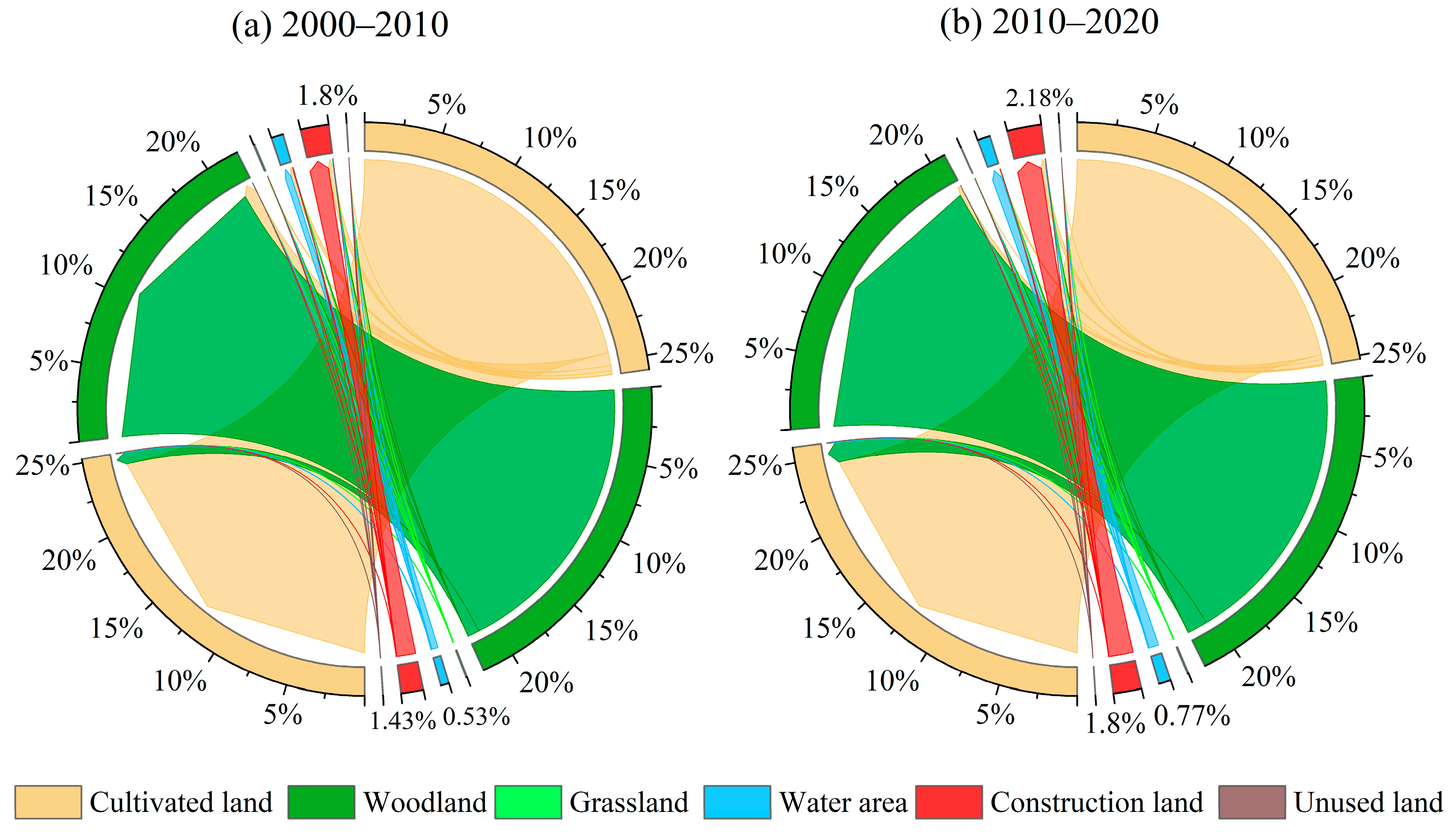
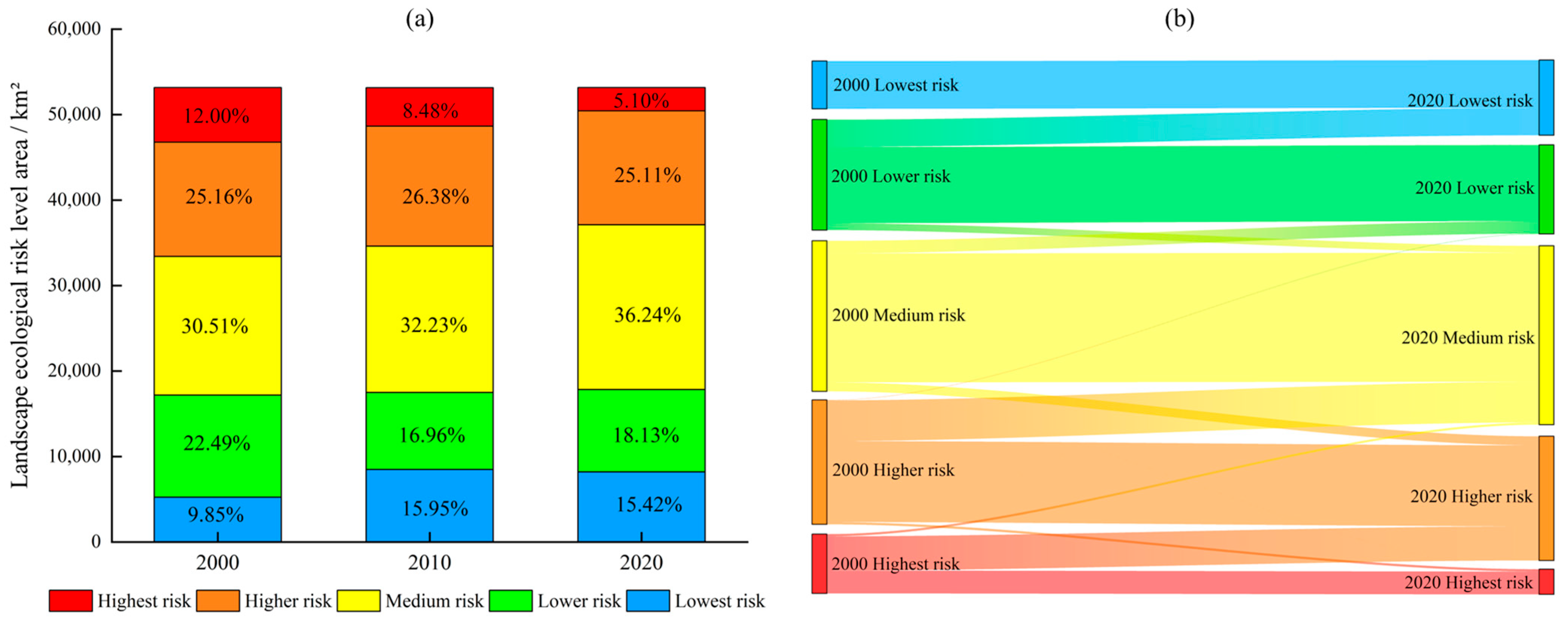
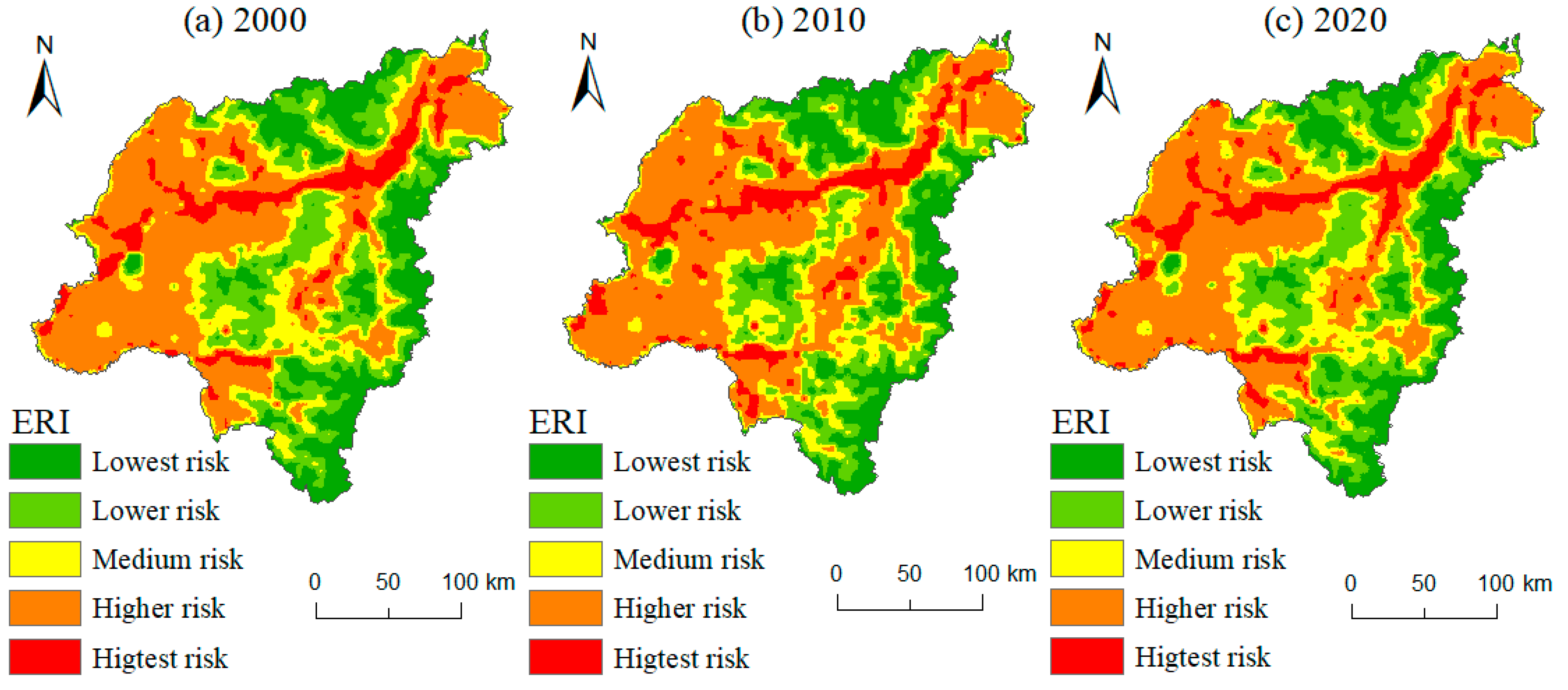
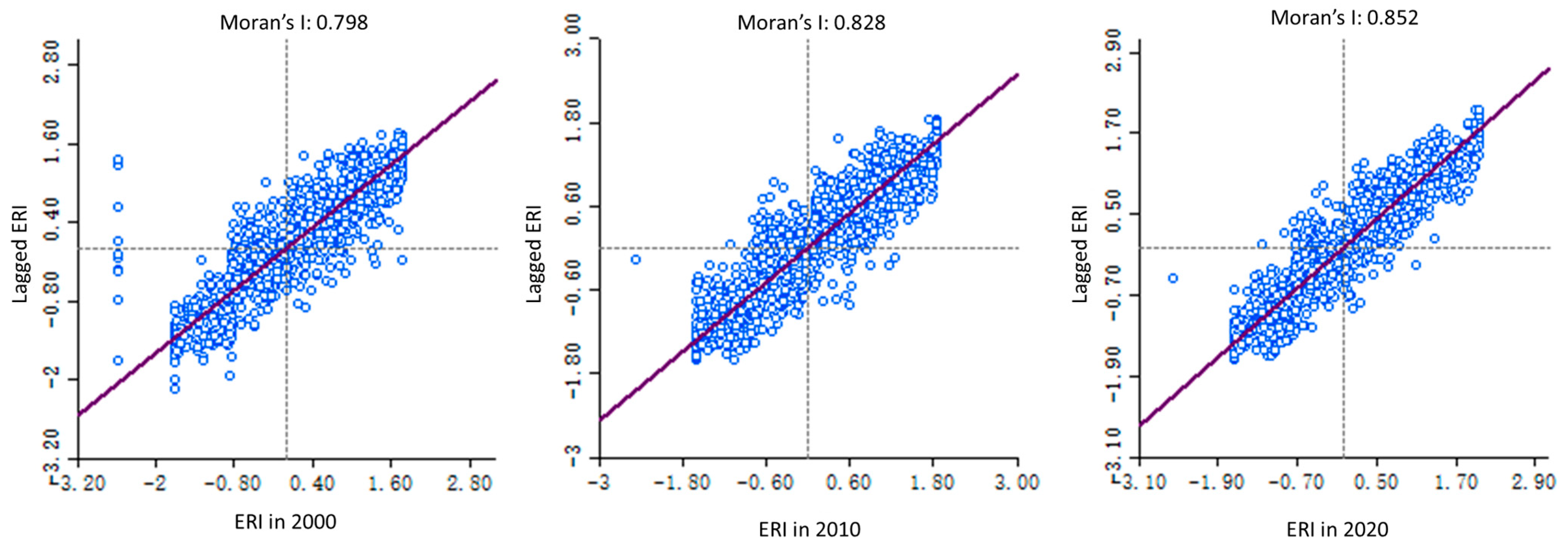
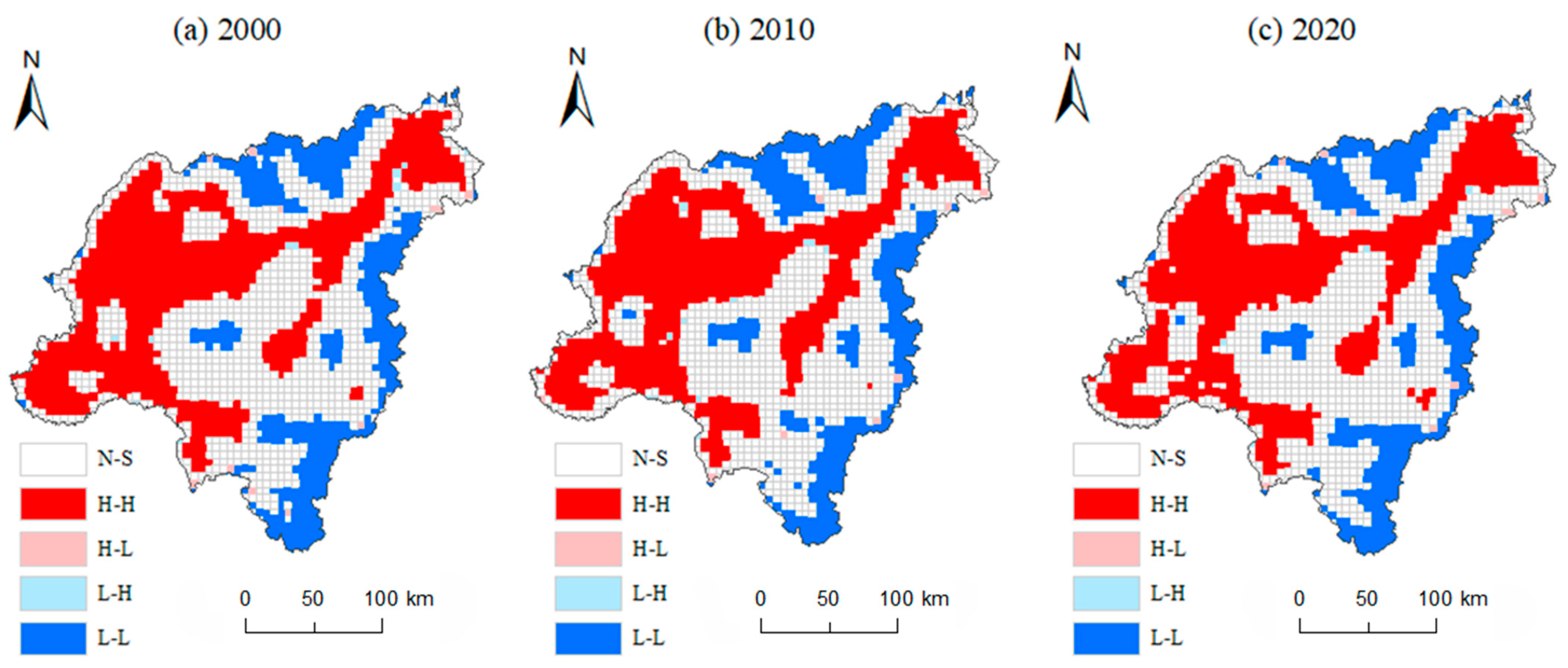
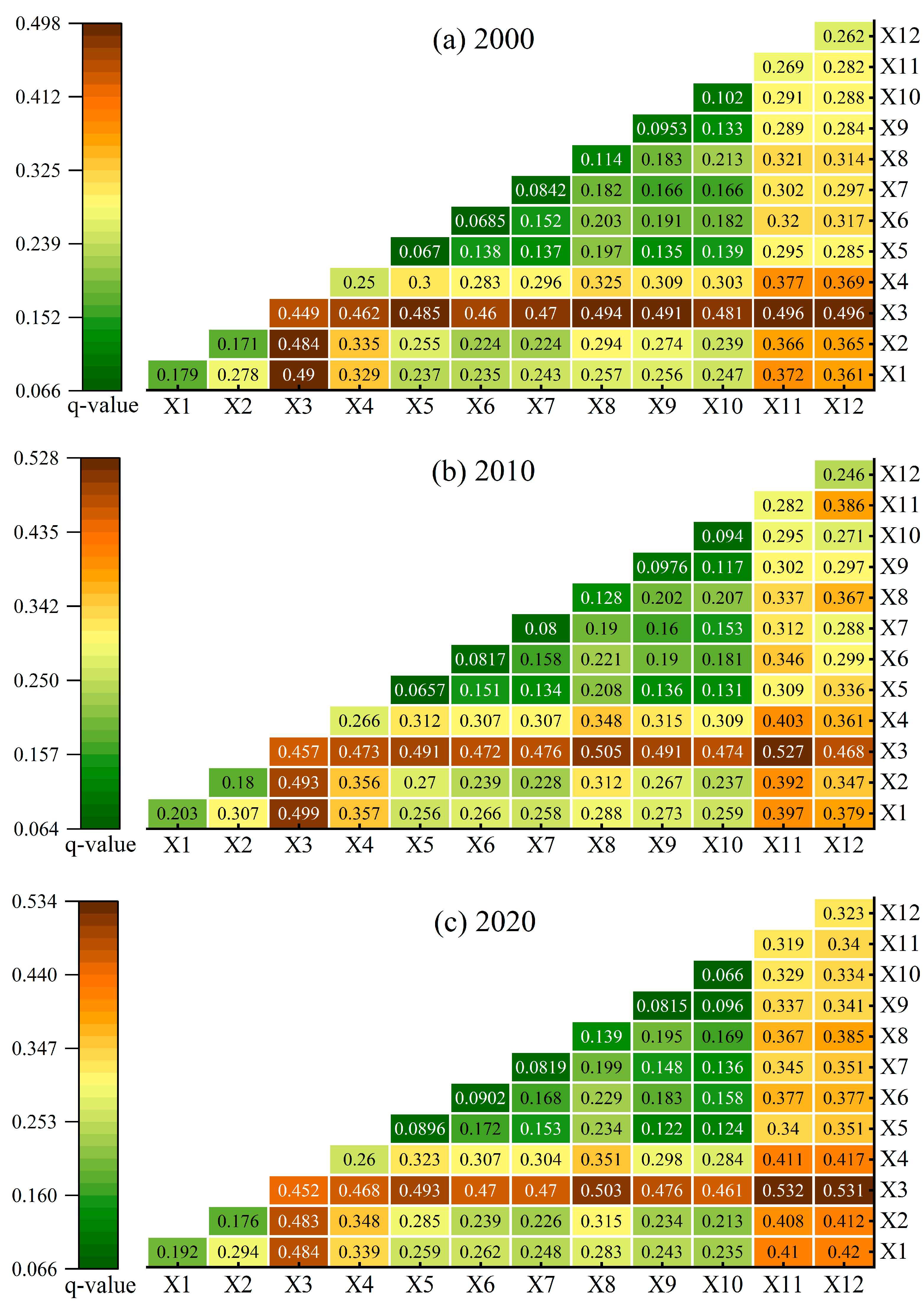
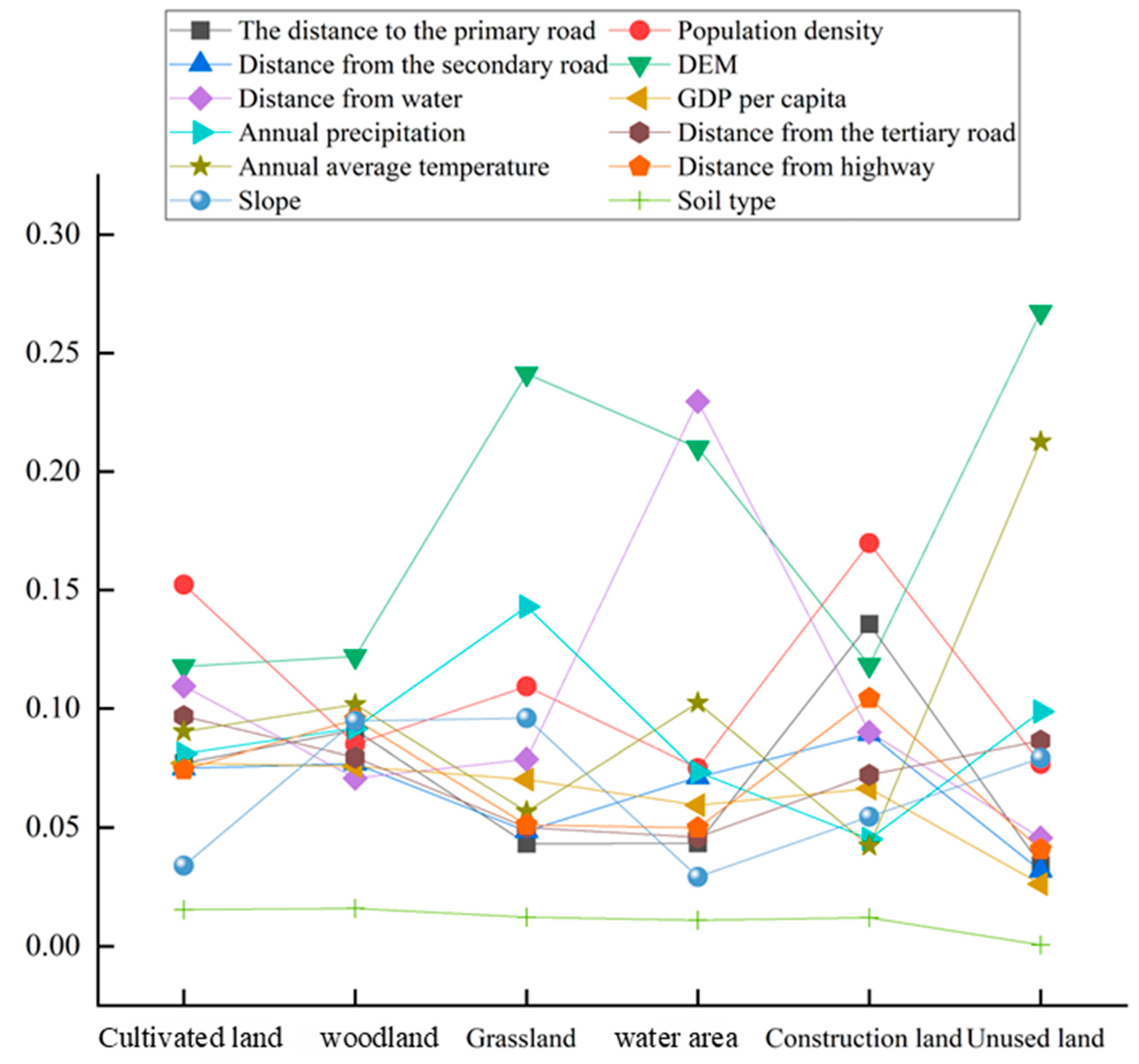

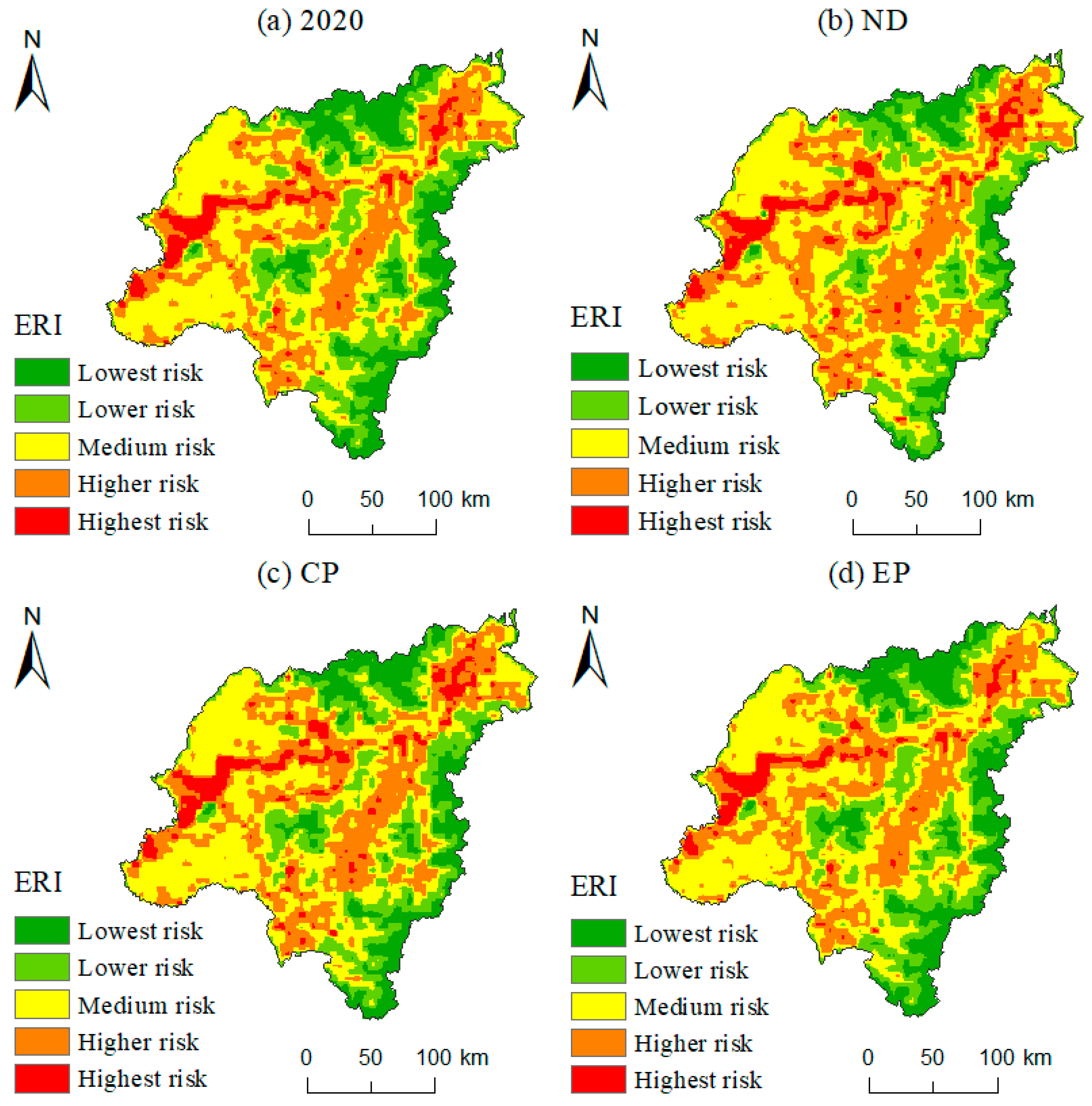
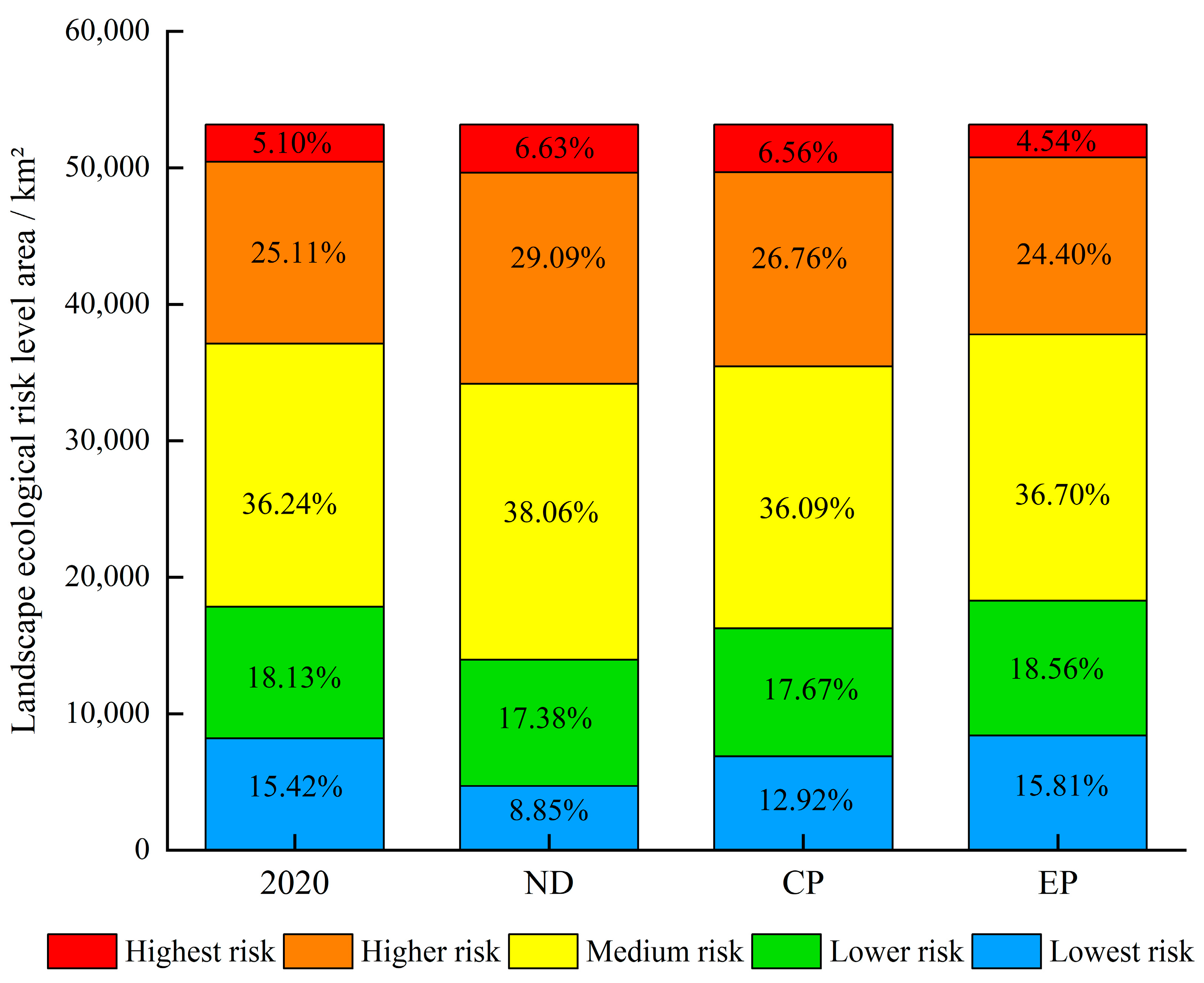
| Scenario | Configuring Parameters |
|---|---|
| ND scenario (I) | Harbin’s land use will continue to change in accordance with the development trends seen between 2000 and 2020, free from human interference or regulatory restrictions. This scenario reflects the intrinsic dynamics of land use change, driven solely by natural trends and market forces, allowing for an unconstrained simulation of future land use transitions. |
| CP scenario (II) | The preservation of farmed land is given priority, which limits its conversion to other land uses. In particular, there is a 60% lower chance that farmland will become urban, hence preventing construction land growth into agricultural areas. This scenario aligns with national policies on farmland conservation and aims to ensure food security while balancing regional development needs [56]. |
| EP scenario (III) | The scenario limits the growth of construction land while prioritizing ecological protection and taking into account carrying capacity for resources and the environment. The specific constraints applied in this scenario include reducing the probability of forest land and grassland converting to construction land by 50%, lowering by 40% the likelihood that arable land will be turned into building land, and increasing by 10% the likelihood that land used for building will eventually become forest land. This scenario aligns with sustainable development goals, aiming to enhance ecological stability, promote environmental conservation, and support regional green development [57]. |
| Landscape Type | ND | CP | EP | |||||||||||||||
|---|---|---|---|---|---|---|---|---|---|---|---|---|---|---|---|---|---|---|
| a | b | c | d | e | f | a | b | c | d | e | f | a | b | c | d | e | f | |
| a | 1 | 1 | 1 | 1 | 1 | 1 | 1 | 0 | 0 | 0 | 0 | 0 | 1 | 1 | 1 | 1 | 0 | 1 |
| b | 1 | 1 | 1 | 1 | 1 | 1 | 1 | 1 | 1 | 0 | 0 | 1 | 0 | 1 | 0 | 0 | 0 | 0 |
| c | 1 | 1 | 1 | 1 | 1 | 1 | 1 | 1 | 1 | 1 | 1 | 1 | 0 | 1 | 1 | 1 | 0 | 0 |
| d | 0 | 0 | 0 | 1 | 0 | 0 | 1 | 0 | 1 | 1 | 0 | 1 | 0 | 0 | 0 | 1 | 0 | 0 |
| e | 0 | 0 | 0 | 0 | 1 | 0 | 0 | 0 | 0 | 0 | 1 | 0 | 1 | 1 | 1 | 1 | 1 | 1 |
| f | 1 | 1 | 1 | 1 | 1 | 1 | 1 | 1 | 1 | 1 | 1 | 1 | 1 | 1 | 1 | 1 | 1 | 1 |
| Landscape Type | Area/km2 | Variation/km2 | ||||
|---|---|---|---|---|---|---|
| 2000 | 2010 | 2020 | 2000–2010 | 2010–2020 | 2000–2020 | |
| Cultivated land | 27,525.02 | 26,805.77 | 27,619.71 | −719.25 | 813.94 | 94.69 |
| Woodland | 23,469.70 | 23,543.27 | 22,331.00 | 73.58 | −1212.28 | −1138.70 |
| Grassland | 61.23 | 61.31 | 20.48 | 0.09 | −40.84 | −40.75 |
| Water area | 563.44 | 822.27 | 860.06 | 258.83 | 37.79 | 296.62 |
| Construction land | 1520.54 | 1916.87 | 2319.17 | 396.33 | 402.30 | 798.63 |
| Unused land | 14.07 | 4.51 | 3.59 | −9.57 | −0.91 | −10.48 |
| Factor | 2000 | 2010 | 2020 | 2000–2020 | |||
|---|---|---|---|---|---|---|---|
| q | P | q | P | q | P | Rank | |
| Soil type (X1) | 0.179 | 0 | 0.203 | 0 | 0.192 | 0 | 5 |
| Distance to water (X2) | 0.171 | 0 | 0.180 | 0 | 0.176 | 0 | 6 |
| DEM (X3) | 0.449 | 0 | 0.457 | 0 | 0.452 | 0 | 1 |
| Slope (X4) | 0.250 | 0 | 0.266 | 0 | 0.260 | 0 | 4 |
| Distance to primary roads (X5) | 0.067 | 0 | 0.066 | 0 | 0.090 | 0 | 12 |
| Distance to secondary roads (X6) | 0.068 | 0 | 0.082 | 0 | 0.090 | 0 | 11 |
| Distance to tertiary roads (X7) | 0.084 | 0 | 0.080 | 0 | 0.082 | 0 | 10 |
| Distance to highways (X8) | 0.114 | 0 | 0.128 | 0 | 0.139 | 0 | 7 |
| Per capita GDP (X9) | 0.095 | 0 | 0.098 | 0 | 0.081 | 0 | 8 |
| Population density (X10) | 0.102 | 0 | 0.094 | 0 | 0.066 | 0 | 9 |
| Annual average precipitation (X11) | 0.269 | 0 | 0.282 | 0 | 0.319 | 0 | 2 |
| Annual average temperature (X12) | 0.262 | 0 | 0.246 | 0 | 0.323 | 0 | 3 |
| Landscape Type | 2020 | ND | CP | EP | |||
|---|---|---|---|---|---|---|---|
| Area/km2 | Area/km2 | Change Rate | Area/km2 | Change Rate | Area/km2 | Change Rate | |
| Cultivated land | 27,619.71 | 28,304.95 | 2.48% | 28,524.16 | 3.27% | 27,806.10 | 0.67% |
| Woodland | 22,331 | 21,207.05 | −5.03% | 21,434.58 | −4.01% | 22,510.46 | 0.80% |
| Grassland | 20.48 | 16.48 | −19.53% | 12.80 | −37.50% | 18.53 | −9.54% |
| Water area | 860.06 | 900.27 | 4.68% | 860.17 | 0.01% | 900.75 | 4.73% |
| Construction land | 2319.17 | 2716.98 | 17.15% | 2319.10 | 0.00% | 1914.97 | −17.43% |
| Unused land | 3.59 | 3.18 | −11.42% | 3.18 | −11.50% | 3.18 | −11.33% |
Disclaimer/Publisher’s Note: The statements, opinions and data contained in all publications are solely those of the individual author(s) and contributor(s) and not of MDPI and/or the editor(s). MDPI and/or the editor(s) disclaim responsibility for any injury to people or property resulting from any ideas, methods, instructions or products referred to in the content. |
© 2025 by the authors. Licensee MDPI, Basel, Switzerland. This article is an open access article distributed under the terms and conditions of the Creative Commons Attribution (CC BY) license (https://creativecommons.org/licenses/by/4.0/).
Share and Cite
Li, Y.; Liu, J.; Zhu, Y.; Wu, C. Assessment of Landscape Ecological Risks Driven by Land Use Change Using Multi-Scenario Simulation: A Case Study of Harbin, China. Land 2025, 14, 947. https://doi.org/10.3390/land14050947
Li Y, Liu J, Zhu Y, Wu C. Assessment of Landscape Ecological Risks Driven by Land Use Change Using Multi-Scenario Simulation: A Case Study of Harbin, China. Land. 2025; 14(5):947. https://doi.org/10.3390/land14050947
Chicago/Turabian StyleLi, Yang, Jiafu Liu, Yue Zhu, and Chunyan Wu. 2025. "Assessment of Landscape Ecological Risks Driven by Land Use Change Using Multi-Scenario Simulation: A Case Study of Harbin, China" Land 14, no. 5: 947. https://doi.org/10.3390/land14050947
APA StyleLi, Y., Liu, J., Zhu, Y., & Wu, C. (2025). Assessment of Landscape Ecological Risks Driven by Land Use Change Using Multi-Scenario Simulation: A Case Study of Harbin, China. Land, 14(5), 947. https://doi.org/10.3390/land14050947






